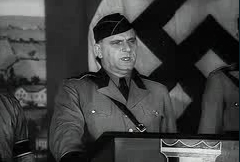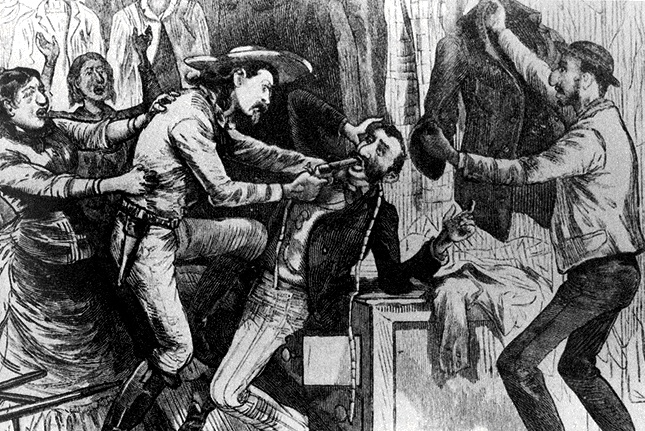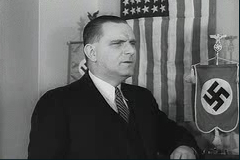Arnie Bernstein’s Swastika Nation: Fritz Kuhn and the Rise and Fall of the German-American Bund leads us through the frightening and surprising journey of the development of this party, the German-American Bund. At the center of the story is the titular Fritz Kuhn, who eventually became known as the Bundesführer, the leader of the German-American Bund. Looking towards America for his future, Kuhn, a German-American immigrant, discovered that America’s attitude toward immigrants such as himself was not always accepting. Discrimination against German-Americans caused men like Kuhn to “look back to the Fatherland and Hitler’s expanding Nazi movement” (19).
Bernstein follows Kuhn’s rise to power, beginning with his job at the Ford Motor Company, which introduced him to The Friends of New Germany (22), a group “steeped in German politics and culture [that] openly admired the growing power of the Nationalsozialistische Deutsche Arbeiterpartei, commonly known as the NSDAP, the Nazi Party” (22). Detroit was a perfect environment for the group to grow, not only because of Ford’s company’s homegrown anti-Semitism but because Judeophobia was brewing in the city, with such colorful figures as Father Coughlin, whose Detroit-based radio program fueled hatred towards Jews (29).
Bernstein shows the complexity of American identity through Kuhn. Kuhn becomes a “full-fledged American” while at the same time remaining “loyal to Germany” (31). On becoming a member of The Friends, he declared, “I herewith declare my entry into the League of the Friends of the New Germany… I am of Aryan descent, free of Jewish or colored racial traces.” The Friends organization gained national attention and developed programs that soon became seen as “un-American” (39). In response to this criticism, Kuhn decided that the focus of the group had to change. The organization had to become American first and integrate Nazism into it, so that American citizens would not view it as anti-American (41). Bernstein brilliantly shows how Kuhn transformed Nazism into Americanism.
Kuhn changed the name of Friends of Germany to the German-American Bund, making it into an “all-American organization” (48). Kuhn’s booklet for the new organization, Awake and Act, emphasized the ways that the Bund would be beneficial for Americans. Bernstein observes that “only three years ago Fritz Kuhn had been nothing more than a minor cog in the Henry Ford complex. Now, through hard work, conniving moves, and seeming sheer will, he was the Bundesleiter of Der Amerikadeutscher Bund, a man poised to emulate the great Adolf Hitler and bring a glorious fascist government, a Swastika Nation of his own making, to the United States of America” (50).
Bernstein shows the ways Kuhn made his organization into an American one, whether it was by using the Declaration of Independence in the Bund’s constitution (52) or glorifying George Washington as an Aryan (178). Bernstein reveals that the German-American Bund did not share a relationship with the Nazis in Europe (67) but rather became a movement with the same thought process in America. Shockingly, the Bund attained between 6- and 8,000 followers, although it never grew to the 200,000 members that Kuhn foresaw (67).
Intermixed with the story of the rise of the German-American Bund, Bernstein presents the voices that opposed the group. Through the power of pen, journalist Walter Winchell made Kuhn his target and began a fierce writers’ battle. The journalist developed his own vocabulary of derogatory nicknames (“Ratzis”, “Swastinkas”, and “Swatsi-Cooties”) for the German-American Bund in order to stress the ridiculous nature of the organization, and he also had a choice set of names for Kuhn (“The Shamerican”, “Kuhnazi,” and “Fritz Kuhn, the local anesthetic”) (75).
Bernstein demonstrates that not all German-Americans were in favor of the Bund, which provides a complex view of German-Americans at the time (86). There was even tension within the Bund between group members. Bernstein delves into different ways that the German-American bund stirred controversy with New York mayor LaGuardia, the Jewish mobsters, and Hollywood. But the Jewish gangsters stole the show with their passion to fight back to defend Jews and not to be passive towards the German-American Bund.
The most unexpected aspect of the book is Bernstein’s revelation that there was a connection between the American Indian Federation and the German-American Bund. This is particularly surprising, considering that Native Americans would never fit the Aryan ideal. But Bernstein explores the ways that AIF embraced and perpetuated anti-Semitism within the organization. Bernstein provides the example of the American Nation Conference in Asheville, where AIF activist Alice Lee Jemision and anti-Semitic leader of the Silver Legion, William Dudley Pelley, shared a stage and “Native Americans sporting swastika armbands worked the audience, handing out pro-Nazi pamphlets” (97). As Bernstein observes, “Native Americans, while not viewed as racially pure, were a unique market for Bundist manipulation” (98). What does this peculiar relationship tell us about race, ethnicity, and the position of Native Americans in the United States in the ‘30s?
As Bernstein continues to follow the rise and the life of Kuhn and the development of the German-American Bund, he doesn’t let the reader lose sight of the clear difference between Nazi America and Nazi-occupied Europe. The German-American Bund did not gain widespread power and acceptance within America, as in the United States the fear of Nazism and communism took center stage. Bernstein explores the fall of the German-American Bund and the growing acceptance that it did not deserve the name “American” in the title, as it did not represent the ideals of what the country stood for.
Yet the author leaves us with a haunting conclusion, reminding us of the indirect legacy of Kuhn’s German-American Bund. Nazism in America did not stop with Kuhn, but continued “in the rubble of the swastika nation” (300) with leaders like George Lincoln Rockwell and David Duke. There have been books like the Turner Diaries, which viciously attacked Jews and African-Americans in favor of a white gentile world, and events like the infamous Nazi march in Skokie, Illinois in 1977. Bernstein points out that “violent Aryan groups” (301) still creep into the 21st century. His book shows that we cannot assume that Nazism could not happen here in America, because it could—and it has.





